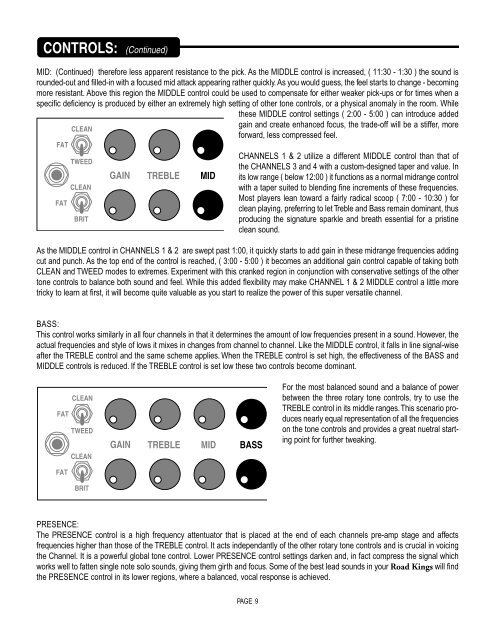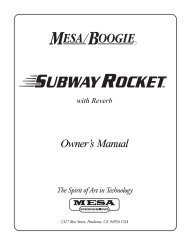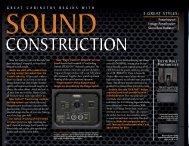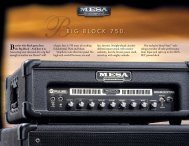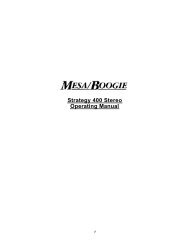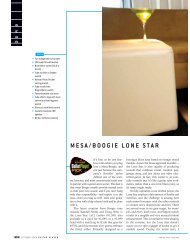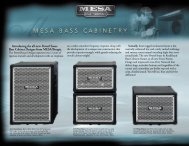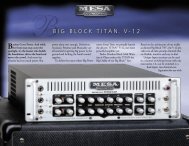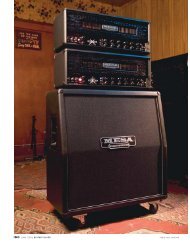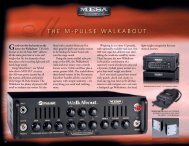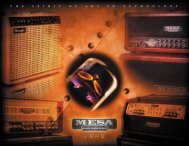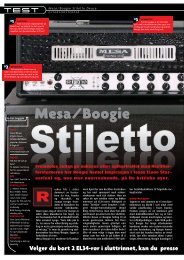Road King Manual - Mesa Boogie
Road King Manual - Mesa Boogie
Road King Manual - Mesa Boogie
- No tags were found...
Create successful ePaper yourself
Turn your PDF publications into a flip-book with our unique Google optimized e-Paper software.
CONTROLS: (Continued)MID: (Continued) therefore less apparent resistance to the pick. As the MIDDLE control is increased, ( 11:30 - 1:30 ) the sound isrounded-out and filled-in with a focused mid attack appearing rather quickly. As you would guess, the feel starts to change - becomingmore resistant. Above this region the MIDDLE control could be used to compensate for either weaker pick-ups or for times when aspecific deficiency is produced by either an extremely high setting of other tone controls, or a physical anomaly in the room. Whilethese MIDDLE control settings ( 2:00 - 5:00 ) can introduce addedgain and create enhanced focus, the trade-off will be a stiffer, moreCLEANforward, less compressed feel.FATCHANNELS 1 & 2 utilize a different MIDDLE control than that ofTWEEDthe CHANNELS 3 and 4 with a custom-designed taper and value. InGAIN TREBLE MID its low range ( below 12:00 ) it functions as a normal midrange controlCLEANwith a taper suited to blending fine increments of these frequencies.Most players lean toward a fairly radical scoop ( 7:00 - 10:30 ) forFATclean playing, preferring to let Treble and Bass remain dominant, thusBRITproducing the signature sparkle and breath essential for a pristineclean sound.As the MIDDLE control in CHANNELS 1 & 2 are swept past 1:00, it quickly starts to add gain in these midrange frequencies addingcut and punch. As the top end of the control is reached, ( 3:00 - 5:00 ) it becomes an additional gain control capable of taking bothCLEAN and TWEED modes to extremes. Experiment with this cranked region in conjunction with conservative settings of the othertone controls to balance both sound and feel. While this added flexibility may make CHANNEL 1 & 2 MIDDLE control a little moretricky to learn at first, it will become quite valuable as you start to realize the power of this super versatile channel.BASS:This control works similarly in all four channels in that it determines the amount of low frequencies present in a sound. However, theactual frequencies and style of lows it mixes in changes from channel to channel. Like the MIDDLE control, it falls in line signal-wiseafter the TREBLE control and the same scheme applies. When the TREBLE control is set high, the effectiveness of the BASS andMIDDLE controls is reduced. If the TREBLE control is set low these two controls become dominant.CLEANFATTWEEDCLEANFATBRITGAIN TREBLE MID BASSFor the most balanced sound and a balance of powerbetween the three rotary tone controls, try to use theTREBLE control in its middle ranges. This scenario producesnearly equal representation of all the frequencieson the tone controls and provides a great nuetral startingpoint for further tweaking.PRESENCE:The PRESENCE control is a high frequency attentuator that is placed at the end of each channels pre-amp stage and affectsfrequencies higher than those of the TREBLE control. It acts independantly of the other rotary tone controls and is crucial in voicingthe Channel. It is a powerful global tone control. Lower PRESENCE control settings darken and, in fact compress the signal whichworks well to fatten single note solo sounds, giving them girth and focus. Some of the best lead sounds in your <strong>Road</strong> <strong>King</strong>s will findthe PRESENCE control in its lower regions, where a balanced, vocal response is achieved.PAGE 9


